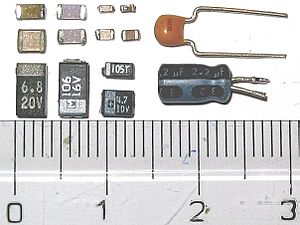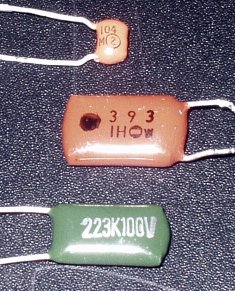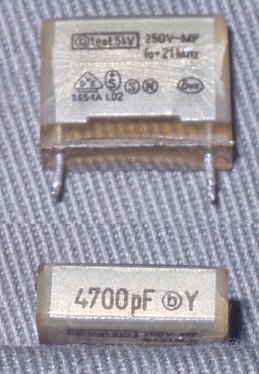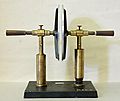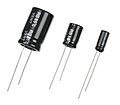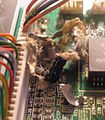Capacitor facts for kids
A capacitor is an electronic part that stores electrical energy. Think of it like a tiny, super-fast battery! Unlike regular batteries, capacitors can charge up and release all their stored energy very, very quickly. This makes them useful in many electronic devices we use every day.
Capacitors are usually made with two metal plates that are very close to each other but don't touch. When electricity flows into them, they store energy in an invisible electric field between these plates. Because the plates need a lot of surface area to store even a small amount of energy, they are often rolled up into shapes like cylinders. Sometimes, special capacitors have different shapes for specific jobs. Even two wires close together can act a bit like a capacitor!
Capacitors come in many sizes, from tiny ones smaller than an ant to large ones as big as a dustbin. Some capacitors can even be adjusted. All capacitors have two connections, called leads. Most types are easy to replace if you know a little about electronics. However, one powerful type, the electrolytic capacitor, must be connected correctly. If not, it can get damaged or even burst.
While capacitors store energy like batteries, they can release it almost instantly. This quick release is why they are used in things like defibrillators (which give a quick electric shock to restart a heart) or camera flashes. A capacitor slowly charges up, then quickly lets go of its stored power when a device needs a sudden burst of energy.
Contents
Supercapacitors
Supercapacitors are special capacitors that can hold much more electrical charge than regular ones. They are used to store electricity for things like motors. They are especially helpful when batteries can't release power fast enough.
Polystyrene Film Capacitors
This type of capacitor has a coil inside, which means it's not ideal for very fast-moving electrical signals (high-frequency circuits). However, they can charge and discharge very quickly compared to some other capacitors. They are often used in special circuits called filter circuits or timing circuits that work at speeds up to several hundred thousand cycles per second.
Electrolytic Capacitors
Electrolytic capacitors use a special liquid called an electrolyte inside them. They don't charge and discharge as quickly as film capacitors. A very important thing about them is that they have polarity. This means they have a positive (+) lead and a negative (-) lead, and they must be connected the correct way in a circuit.
There are two main styles:
- Axial: The leads come out of opposite ends.
- Radial: The leads both come out of the same end.
Electrolytic capacitors always have their capacitance (how much charge they can store) and voltage rating (the maximum voltage they can handle) printed on them. It's very important not to put too much voltage through an electrolytic capacitor, as this can damage it.
When connecting electrolytic capacitors in a series (one after another), the positive lead of one must connect to the negative lead of the next. This keeps the polarity correct throughout the electrical circuit and helps prevent the capacitor from breaking down.
Some electrolytic capacitors are unpolarized, meaning either side can be positive or negative. These are often used in loudspeakers. They help block low-frequency sounds (bass) from reaching the parts of the speaker that make high-frequency sounds (tweeters).
Images for kids
-
A group of four Leyden jars, which were early capacitors, in a museum in the Netherlands.
-
This high-energy capacitor from a defibrillator has a safety resistor to release stored energy when not in use.
See also
 In Spanish: Condensador eléctrico para niños
In Spanish: Condensador eléctrico para niños


